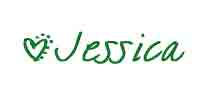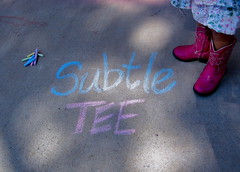Check out:
#1- Needle, needle, needle
#2- Set the right stitch type and length
#3- Tame those hungry feed dogs
#4- Thread Counts
#5- Release a little tension would ya?
The type of needle you use on your machine is the key to success above all else. Especially for light weight knits and jersey fabric (like t-shirts). I use a ballpoint needle (sometimes called a Jersey needle), but you can also use a stretch needle. These fancy needles have a rounded point that penetrates the fabric without catching or cutting through the yarns.
I'm sure you've heard a zigzag stitch recommended when sewing elastics or knits and it's because the zig lets the stitch flex and give a little with the movement of the material. This makes it easy because you don't have to stretch the fabric as you sew. The best setting for a zigzag machine is the narrowest zigzag setting (.5mm on many machines) and a stitch length of 2.5mm to 3mm. For those super thick knits you can use a longer stitch length.
For those with a straight-stitch-only machine don't worry! Just set your stitch length to a medium (2.5mm-3mm) length and it should work just fine. The only catch is when sewing knits with a straight stitch, you need to very carefully and evenly stretch the fabric from both ends. This doesn't have to be a tug-a-war, you just slightly and gently stretch the fabric as it goes under the presser foot. Make sure you're not pulling on one end or the other though, because you could end up pulling and snapping the needle. Yikes! No matter how cranky your kids are all day I doubt anyone really wants to poke their eyes out with a needle.
How do I know what I have???
Most basic sewing machines have a single feed which feeds all layers through together, at the same time. You can test to see if yours does by taking two of the exact same size pieces of fabric and sewing a seam down the center. After you remove them from under the presser foot check the edges of the fabric to see if they are still aligned. If so, then hooray your feed is working well! If not, well shoot, those dogs are pulling either the top or the bottom piece faster than the other. No big deal, you should be able to check your manual and adjust the feed, but it'll require a little trouble shooting back and forth with test strips until you get it.
Having the feed dogs balanced will help, but if you still have too much pull or puckering you can try easing the pressure on the presser foot. I've also heard, but not yet tested that you can put a piece of paper under the fabric before you feed it through the machine to basically eliminate the feed dogs altogether! I've heard it really helps, but you'll have to make sure you're good at evenly and gently stretching the fabric through on both sides. Then, once you're done sewing you just pull the paper out of the seams.
If you're using a serger and having problems with the knits bunching, pulling or puckering, you can also check your feed dogs. Most sergers come with a differential feed knob that you can turn to strengthen or loosen as needed.
Warning about serging with knits.... the serge stitch takes away most of the stretch in the fabric, so it's actually better to sew neck openings or tightly fitted cuffs with a zigzag so they can stretch with the material over the head, hands or feet.
#4- Thread counts
The type of thread that is. Using the lightest weight possible will limit bunching. Instead of the basic cotton thread see how nylon thread works for you
#5- Release a little tension would ya?
For knit fabrics and most stretch material you'll probably need to loosen the bobbin tension, especially if you're working with cotton thread. Always test on a scrap piece of fabric after making any changes. The best stitches for a knit should lay almost flat with a slight raise. Give the fabric a little stretch to make sure the stitches don't break. If you've gone too loose you'll know because the stitches will form “loops” rather than stitches and won't lay flat.
Other random tips
- Always pre-wash knits, because they do definitely shrink.
- Skip the seam finishes! Most knits don't unravel much anyway and the less sewing the less room for unwanted stretch.
- Spray a little ironing starch on the ends to give them some extra stiffness while you're working.
- Sounds too basic to even say, but make sure your machine is recently oiled so the thread doesn't have extra pull coming through.
- Use a double row of stitches on the hem. I'm sure you've noticed that most professional knits use this and unfortunately, they're fancier than most of use SAHM sewers and use a special machine or fancy serger to make this "coverstitch." But even if you don't have a coverstitch most zigzag sewing machines can take double needles, which sews a perfect double row of stitches on the needle side of the fabric and a neat zigzag on the bottom! This stitch has more stretch than a regular stitch and looks impressively professional :) The only drawback is that when you change to a double needle you'll probably have to make some other adjustments to your needle and bobbin tensions. If you want to try this hop over and check out this tutorial for twin needle sewing here.
Please email me or comment away if you've discovered any other tips, I'd love to know!!!
 Sitting in an old fashion high chair and eating oreo cookies
Sitting in an old fashion high chair and eating oreo cookies(it was a tie between the chair or the cookies)





























great tips!! i made a knit shirt the other day-usually i steer clear so that was exciting...lol
ReplyDeletelooking forward to sewing with knits again.... it has been years, thanks for the tips.
ReplyDeleteThanks for these tips!! I am going to attempt to sew with knits and this definitely gives me more confidence - plus now I know that I need to purchase a new needle :)
ReplyDeleteHi found your blog trying to find out how to sew a t shirt quilt - THANK YOU for these tips!! Indeed, it took me a good 2 hrs to adjust everything "just right" for the t's. Luck had it that I had a ball point needle tuck in the back drawer ;-D It took me forever to adjust my bottom feeder foot, as I had never had to do that before, simply because I'd never sewn with jersey knits. Again thanks so much.
ReplyDeleteGetting ready to sew me 6maxi skirts....live the tips
ReplyDeleteThanks so much for your tip on spraying ends with spray starch to stiffen them up a bit while working. I am going to try today!!
ReplyDeleteNumber two just helped me immensely.
ReplyDeleteI do know that knits printed onto cotton knits and cotton knit blends will be more susceptible to fade, knit fabrics
ReplyDeleteGreat post, I've looked for loads of tips on sewing knits so they don't pucker and the feed dogs were never mentioned - this could be my problem. And will defo try the paper-under-fabric tip.
ReplyDeleteThank you! I also find that sewing with tissue paper under my work takes out a lot of the stretch and gives really nice even stitches.
ReplyDeleteizmir
ReplyDeleteErzurum
Diyarbakır
Tekirdağ
Ankara
JVYLX
Yalova
ReplyDeleteHatay
Muş
Bursa
Mersin
K4Q1
görüntülü.show
ReplyDeletewhatsapp ücretli show
HTRTZ
https://titandijital.com.tr/
ReplyDeleteısparta parça eşya taşıma
ankara parça eşya taşıma
izmir parça eşya taşıma
diyarbakır parça eşya taşıma
QQLQ37
ordu evden eve nakliyat
ReplyDeletebursa evden eve nakliyat
konya evden eve nakliyat
osmaniye evden eve nakliyat
bitlis evden eve nakliyat
KN3J
38924
ReplyDeleteSivas Şehirler Arası Nakliyat
order testosterone propionat
Tekirdağ Fayans Ustası
Zonguldak Şehir İçi Nakliyat
Hatay Lojistik
Batman Lojistik
Sakarya Parça Eşya Taşıma
sms onay
Niğde Şehirler Arası Nakliyat
FC0A0
ReplyDeleteÜnye Organizasyon
Çerkezköy Oto Lastik
Osmaniye Parça Eşya Taşıma
Çerkezköy Parke Ustası
Bitlis Parça Eşya Taşıma
Keçiören Parke Ustası
Diyarbakır Lojistik
Adıyaman Şehirler Arası Nakliyat
Giresun Parça Eşya Taşıma
7FF79
ReplyDeleteBingöl Şehirler Arası Nakliyat
Bilecik Şehir İçi Nakliyat
Tekirdağ Parça Eşya Taşıma
Afyon Şehir İçi Nakliyat
Ağrı Şehirler Arası Nakliyat
Kastamonu Şehir İçi Nakliyat
Ordu Şehirler Arası Nakliyat
Sivas Parça Eşya Taşıma
Kaspa Coin Hangi Borsada
BCF4F
ReplyDeleteAğrı Evden Eve Nakliyat
Ardahan Evden Eve Nakliyat
Adana Evden Eve Nakliyat
Pursaklar Parke Ustası
Batman Evden Eve Nakliyat
Mersin Evden Eve Nakliyat
Çerkezköy Cam Balkon
Kütahya Evden Eve Nakliyat
Bitci Güvenilir mi
59C20
ReplyDeletereferans
19BCF
ReplyDeletebinance indirim
06171
ReplyDeleteBitcoin Nasıl Çıkarılır
Coin Nasıl Oynanır
Kripto Para Kazma Siteleri
Binance Hesap Açma
Bitcoin Madenciliği Siteleri
https://resimlimag.net/
Kripto Para Kazanma Siteleri
Binance Nasıl Kayıt Olunur
Kripto Para Nasıl Kazılır
4CC10
ReplyDeleteKripto Para Kazanma Siteleri
Binance Nasıl Kayıt Olunur
Kripto Para Kazma
Okex Borsası Güvenilir mi
Bitcoin Nasıl Para Kazanılır
Kripto Para Çıkarma
Bitcoin Kazanma
Kripto Para Nasıl Alınır
Bitcoin Nasıl Kazılır
6422E
ReplyDeleteBitcoin Madenciliği Nasıl Yapılır
Mexc Borsası Kimin
Bitcoin Yatırımı Nasıl Yapılır
Coin Para Kazanma
Coin Çıkarma Siteleri
Coin Çıkarma Siteleri
Kripto Para Kazanma Siteleri
Yeni Çıkacak Coin Nasıl Alınır
Bitcoin Çıkarma
BA479
ReplyDeletekırklareli görüntülü sohbet yabancı
Bursa Sohbet
eskişehir ücretsiz sohbet odaları
düzce ücretsiz görüntülü sohbet
Bilecik Canli Sohbet Bedava
ücretsiz sohbet siteleri
ığdır Canlı Sohbet Ücretsiz
urfa mobil sohbet odaları
niğde canlı görüntülü sohbet
D73B6
ReplyDeleteen düşük komisyonlu kripto borsası
bitcoin ne zaman yükselir
canlı sohbet uygulamaları
September 2024 Calendar
copy trade nedir
April 2024 Calendar
telegram kripto grupları
2024 Calendar
September 2024 Calendar
شركة تسليك مجاري بالهفوف QQBbqbREEP
ReplyDelete